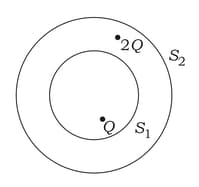Embibe Experts Solutions for Chapter: Electric Charges and Fields, Exercise 1: Meghalaya-2018
Embibe Experts Physics Solutions for Exercise - Embibe Experts Solutions for Chapter: Electric Charges and Fields, Exercise 1: Meghalaya-2018
Attempt the free practice questions on Chapter 1: Electric Charges and Fields, Exercise 1: Meghalaya-2018 with hints and solutions to strengthen your understanding. EMBIBE CHAPTER WISE PREVIOUS YEAR PAPERS FOR PHYSICS solutions are prepared by Experienced Embibe Experts.
Questions from Embibe Experts Solutions for Chapter: Electric Charges and Fields, Exercise 1: Meghalaya-2018 with Hints & Solutions
and are two parallel concentric spheres enclosing charges and respectively as shown in the figure below. What is the ratio of electric flux through and ?

Obtain an expression for the torque on an electric dipole placed in a uniform electric field.
Using Gauss’s theorem in electrostatics, derive an expression for electric field at a point due to an infinitely long line of charge having a uniform charge density.
The force between two equal point charges separated by a certain distance is . If the distance between them is doubled and their individual charges are also doubled, then the force between them is
Use Gauss’s theorem to derive an expression for electric field due to a uniformly charged spherical shell at a point outside the shell.
Use Gauss's law to obtain the expression for the electric field due to a uniformly charged infinite plane sheet.
Distinguish between polar and non-polar dielectrics.
A wire of resistance and length is increased to twice its original length. Calculate its new resistance.
